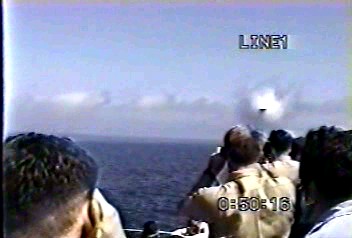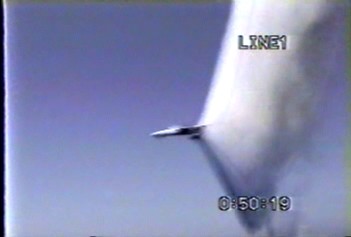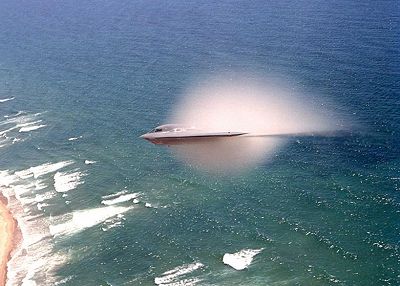All about this photo:
Awesome - Wanna see a sonic boom?
by Bruce Stephen Holms
Ensign John Gay
could see the fighter plane drop from the sky heading
toward the port side of the aircraft carrier Constellation.
At 1,000 feet, the pilot drops the F/A-18C Hornet to
increase his speed to 750 mph, vapor flickering off the
curved surfaces of the plane.
In the precise moment a cloud in the shape of a farm-fresh
egg forms around the Hornet 200 yards from the carrier, its
engines rippling the Pacific Ocean just 75 feet below, Gay
hears an explosion and snaps his camera shutter once.
"I clicked the same time I heard the boom, and I knew I had
it," Gay said.
What he had was a technically meticulous depiction of the
sound barrier being broken July 7, 1999, somewhere on the
Pacific between Hawaii and Japan. Sports Illustrated,
Brills Content and Life ran the photo. The photo recently
took first prize in the science and technology division in the
World Press Photo 2000 contest,
which drew more than
42,000 entries worldwide. "All of a sudden, in the last few
days, I've been getting calls from everywhere about it again.
It's kind of neat," he said, in a telephone interview from his
station in Virginia Beach, VA.
A naval veteran of 12 years, Gay, 38, manages a crew of
eight assigned to take intelligence photographs from the
high-tech belly of an F-14 Tomcat, he fastest fighter in the
U.S. Navy. In July, Gay had been part of a Joint Task Force
Exercise as the Constellation made its way to Japan.
Gay selected his Nikon 90 S, one of the five 35 mm cameras he
owns. He set his 80-300 mm zoom lens on 300 mm, set his shutter
speed at 1/1000 of second with an aperture setting of F5.6.
"I put it on full manual, focus and exposure," Gay said. "I tell
young photographers who are into automatic everything, you
aren't going to get that shot on auto. The plane is too fast.
The camera can't keep up." "At sea level a plane must exceed
741 mph to break the sound barrier, or the speed at which
sound travels.
The change in pressure as the plane outruns all
of the pressure and sound waves in front of it is heard on the
ground as an explosion or sonic boom. The pressure change condenses the
water in the air as the jet passes these waves. Altitude, wind speed,
humidity, the shape and trajectory of the plane - all of these affect the
breaking of this barrier. The slightest drag or atmospheric pull on the
plane shatters the vapor oval like fireworks as the plane passes through,"
he said.
"Everything on July 7 was perfect," he said. "You see this vapor flicker
around the plane that gets bigger and bigger. You get this loud boom, and
it's instantaneous. The vapor cloud is there, and then it's not there.
It's the coolest thing you have ever seen."
(This article was sent to me by Carter Slusher)
This photo has been around (and asked about) enough that it
is listed in these US Navy FAQs as
The shot seen 'round the world,
with a higher resolution copy
and the following description. (Thanks to Michael Manlin for
sending me this info.)
An F/A-18 Hornet assigned to Strike Fighter Squadron One Five One
(VFA-151) breaks the sound barrier in the skies over the Pacific Ocean,
July 7, 1999. VFA-151 is currently deployed with USS Constellation (CV 64).
U.S. Navy photo by Ensign John Gay. July 7, 1999.
Ensign John Gay, photo officer for Fighter Squadron Two (VF 2), shot this
image from the 0-10 level weather deck (the uppermost deck on the island) of
USS Constellation (CV 64). It was shot with a Nikon N-90s with a Nikon 70-300
ED zoom lens, using Kodacolor 200 negative film. The camera was set for
manual exposure of F/5.6 at 1/1000 sec. The image was acquired with a single
shot, panned from left to right, prefocused at approximately 200-300 yards
off the port side of the ship, where the aircraft flew by.
Find this photo at as #990707-N-6483G-001
in the US Navy Eye on the Fleet Photo Gallery,
where they note that it was taken off the coast of Pusan, South Korea.
(high resolution copy)
DefenseLink:
The Sight of Sound
also posted the photo and a higher resolution copy
(958k) with the following description.
Navy Lt. Ron Candiloro's F/A-18 Hornet creates a shock wave as he breaks the
sound barrier July 7. The shock wave is visible as a large cloud of condensation formed by the
cooling of the air. A smaller shock wave can be seen forming on top of the canopy.
It is possible for a skilled pilot to work the plane's throttle to move the shock
wave forward or aft. Candiloro is assigned to Fighter Squadron 151, currently deployed with
the USS Constellation battle group. (U.S. Navy photo by Ensign John Gay)
The explanation that came in an email with this photo and video:
This is extra ordinary photography, once in a life time photo. Hope you
enjoy. Every so often, just the right combination of conditions and
events occur to create an unbelievable event-in this case an F-18 passing
through the sound barrier. Not only were the water vapor, density and
temperature just right, but there just happened to be a camera in the
vicinity to capture the moment. The F-18 is actually in transonic flight,
with normal shock waves emanating from behind the canopy and across the
wings and fuselage. The condition will last for only an instant, and once
supersonic flow exists completely around the aircraft, sharp-angled sonic
cones replace the normal shock waves. The odds of getting a shot like this
are staggering.
|
Other photos of the same effect:
7/2007 New!
 iStockPhoto
contributors have captured this effect too with a variety of aircraft.
Here is a lightbox/gallery with some of their shots.
These are high-quality photos, and are for sale (by them, not me).
And links to some individual photos...
iStockPhoto
contributors have captured this effect too with a variety of aircraft.
Here is a lightbox/gallery with some of their shots.
These are high-quality photos, and are for sale (by them, not me).
And links to some individual photos...
 F-22A Raptor's:
3490739,
3490794,
3144449,
3449195,
3158085,
2255168,
3351670,
F-18's:
474872,
1011883,
1020731,
3293746,
F-15's:
3449353,
3449365,
3486093,
F-16's:
1004304,
1832402,
1065161,
1114649,
F-111's:
1827647
(if you join istockphoto, please do me a favor and list me 'jwilkinson' as referrer. thx!)
F-22A Raptor's:
3490739,
3490794,
3144449,
3449195,
3158085,
2255168,
3351670,
F-18's:
474872,
1011883,
1020731,
3293746,
F-15's:
3449353,
3449365,
3486093,
F-16's:
1004304,
1832402,
1065161,
1114649,
F-111's:
1827647
(if you join istockphoto, please do me a favor and list me 'jwilkinson' as referrer. thx!)
ChamorroBible.org has quite a lot of great
photos in their Prandtl-Glauert Condensation Clouds Collections:
1,
2,
3,
4,
5.
Each collection has photos, details, credits, links to high-res
photo copies and lots of links to more.
Be sure to check the
US Navy Eye on the Fleet Photo Gallery
for tons of great photos. Here are a few of the vapor effect.
1445,
1386,
2827,
4598,
7030,
8767,
11676,
14863,
17909,
19053,
23018,
23503,
26590,
26610,
27228.
27251,
27327,
28334,
34239,
37555,
37558,
39127,
39129,
39964,
39972,
40228,
40674.
All Hands Gallery:
1066.
You can see an F-4
creating the vapor cone as it breaks the sound barrier at
OK3
or Physics Movies.
F/A-18 vapor cone at Moffett airshow 8/11/01
Nick Chinn says: I was at the Moffett Air Expo on Saturday,
August 11, 2001 and they had a high speed F/A-18 flyby. He approached the speed
of sound but there was no sonic boom so he did not break it (this is a mostly
residential area). The air was certainly crackling though! A vapor cone still
formed and I caught a
couple pictures of it.
(pics are toward the bottom) The shots were taken with a Canon D30 digital SLR
and a 100-400mm zoom.
Doug Wade also has
some great photos
from the Moffett Air Expo including some with the vapor cones. He says "the
technical quality isn't as good as Nick Chinn's but you can see how sharp the
thing became at one moment."
Yung Chen from Canada sent in a note
that he caught some good pics of this effect at the 2001
London Air show. See them under
Photo Album: F14-B
Here's a nice photo by Gregg Stansbery with condensation effect as a
B1-B makes a high-speed pass
very near the sound barrier at the Pensacola Beach airshow. From the 127th
BS/184th BW, Kansas ANG. (also here)
Related Links:
|



